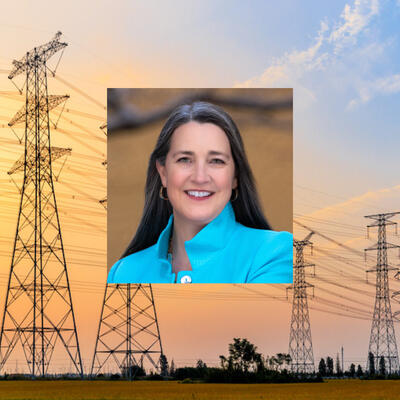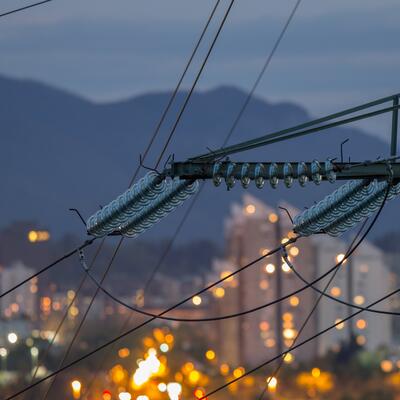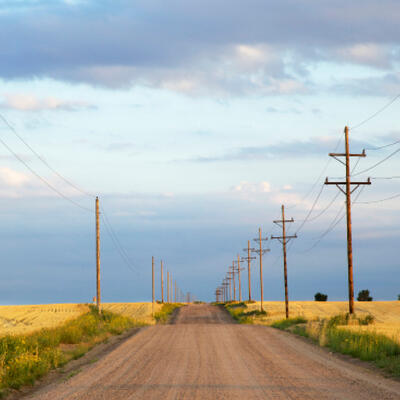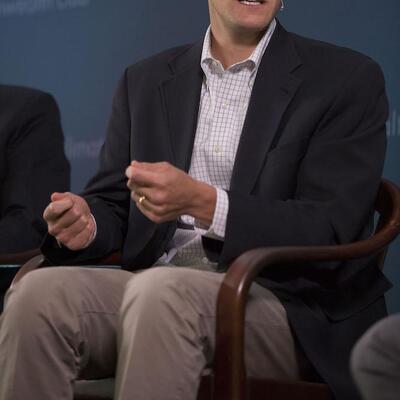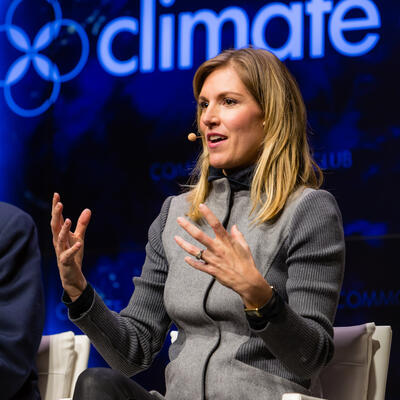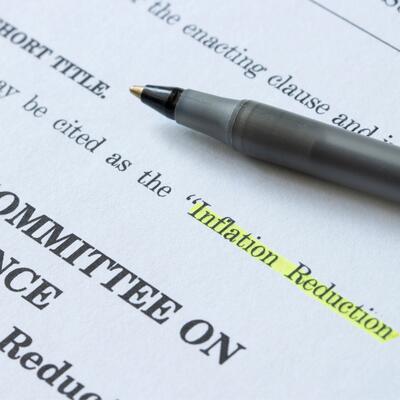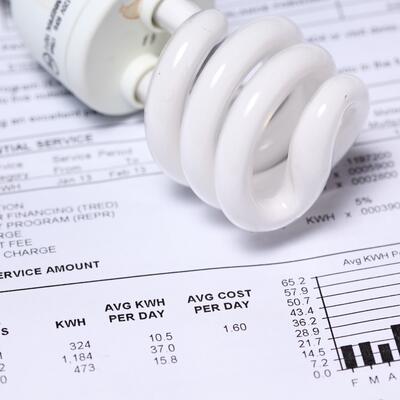
Making Cents Out of Watts: What’s Driving Up Your Energy Bills?
Guests

Shelley Welton
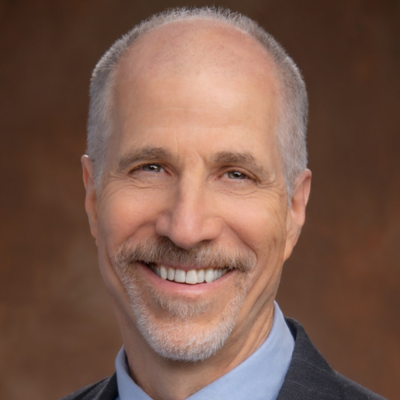
Severin Borenstein

Kevin Miller
Summary
Across the country, people are seeing their electric bills go up, sometimes painfully so. “A third of Americans say that they've skipped food, medicine, [or] something to be able to afford their energy bills recently,” says Shelley Welton, professor of law and energy policy at the University of Pennsylvania Carey School of Law and the Kleinman Center for Energy Policy.
There are two big categories that go into determining how much you will pay for electricity: Generation – how the electricity is made, and transmission and distribution – how it gets to your house. How those categories get calculated really depends on where you live.
“In some places, your utility might own all of that supply themselves and they're just charging you for whatever it costs them to build it and maintain it,” says Welton. “In other places, you may get your electricity supply largely from electricity markets, and so the prices that are going on in those markets are going to drive that generation piece of the bill.”
The transmission part of your bill goes to building and maintaining all the wires needed to move power from the generating plant to your home. Generally, how much you pay for both generation and transmission is based on how much electricity you consume. But there are also “fixed costs.”
That fixed price is on your electric bill no matter how much electricity you consume,” says Welton. The more fixed costs that are in an electric bill, the less control a consumer has over how much their bill will be. “Unless you decide that you want to be more proactive and become a generator yourself, it does come down to what you consume and how much you can control what you consume,” says Welton.
In Maine, soaring electricity prices caused some in the state to propose a different model, a nonprofit called Pine Tree Power. The idea was that Pine Tree Power, “would be run by a board whose members would be elected by Maine voters. So in theory, this nonprofit would be more responsive to Maine's electric customers and less interested in generating profit for investors or to private companies,” says State House correspondent for Maine Public Radio, Kevin Miller. But in order for the nonprofit to be enacted, it would have to pass as a ballot measure.
“The electric utilities were strongly opposed to this. They were calling it government takeover power,” says Miller. In the end, the voters did not go for the new model, “It's easier frequently for people to say no than to take a leap on something that would be a major change,” says Miller. But proponents said they would continue to advocate for their beliefs and continue to put pressure on the utilities.
Some say California’s increasing reliance on renewable energy is to blame for high electricity prices. But Severin Borenstein, professor of business administration and public policy at the Haas School of Business and faculty director of the Energy Institute at Haas, says that’s not true. He argues that most of the rise in rates comes from the state’s desire to push the costs of climate impacts onto consumers’ electric bills rather than from the state budget.
“Paying for it through electricity prices means that lower income people pay a larger share of their income towards covering these costs than high income people do,” says Borenstein
Worse, says Borenstein, the state is creating the wrong incentives for consumers. “We want them to get electric vehicles. We want them to put in heat pumps. And by doing this, we're undermining their incentive to electrify.”
Episode Highlights
2:46 - Shelley Welton explains what goes into an electric bill
5:32 - Shelley Welton on fixed charges
15:12 - Shelley Welton on the role people can take to reduce their energy bills
20:04 - Kevin Miller on Maine’s attempt to try a different utility model
24:02 - Kevin Miller on why the new model lost with voters
27:43 - Shelley Welton on other power options for communities
35:23 - Shelley Welton on recommendation for low cost, low carbon electricity
38:23 - Severin Borenstein on California’s rising electricity costs
41:31 - Severin Borenstein on the renewables and high prices
46:15 - Severin Borenstein on regressive billing practices
Resources From This Episode (5)
Full Transcript
Note: Transcripts are generated using a combination of automated software and human transcribers and may contain errors. Please check the actual audio before quoting it.
Greg Dalton: I’m Greg Dalton.
Ariana Brocious: And I’m Ariana Brocious.
Greg Dalton: And this is Climate One.
[music change]
Ariana Brocious: Greg, have you ever tried to decipher your electric bill? I mean, we all look at the bold line that tells you how much you owe. But all the other lines with details about how much the power costs, etc?
Greg Dalton: Yes, I’v spent a painful amount of time looking at my electric bill. I know the difference between generation – making the energy – and transmission – sending it to my house. I pay a few dollars extra for 100 percent renewable juice. And like all customers in California, I get about $100 credit on my bill each year from the state’s cap and trade program. I get that. But there are a lot of other lines I don’t understand. I’ve also had solar panels on my house for years and that makes the calculations even more complicated.
Ariana Brocious: Yeah, I got solar panels about a year ago and had a little sticker shock a few months ago, because my bill was not as low as the solar company had predicted it would be. So I actually ended up going through the bill with one of their analysts on the phone and it turns out my household is just using a LOT more electricity than we were a year ago, because we’ve electrified everything.
Greg Dalton: Funny how that works. And add batteries and it gets even more complicated. And these line items on your bill matter because it can tell you about how your power company is making and moving electricity, and what else they might be charging you for. In California, there’s been a lot of talk about utilities charging customers for the cost of undergrounding power lines to make them less likely to start wildfires. Preventing fires sounds like a good idea to me. And it’s expensive.
Ariana Brocious: Yeah, and it makes me wonder who should really be paying for it – the customers or the company. We’ll get deep into that question later in the show.
First, you’re probably among the millions of people who are feeling the pain of rising electric bills. At the same time you may be frustrated by your utility’s resistance to move to greener, and often cheaper, sources of energy. I know I am. So today we’re going to dig into this – how your electricity bill is calculated, who’s in charge of setting those rates and making decisions about the costs, and what you can or can’t do to change it.
[music cue]
Ariana Brocious: Shelley Welton is a professor of law and energy policy at the University of Pennsylvania. I invited her on the show to help me understand what goes into calculating an electric bill – and who makes those decisions. Like many of us, she’s been seeing much higher bills lately.
Shelley Welton: Our electricity here in Pennsylvania is largely gas and then you know, when we run our heat on gas and you have a cold winter, like price spikes are painful. So you have these like fairly normal looking bills for most of the year and then you get a cold January and our bill was almost $500 and that just feels super untenable, right?
Ariana Brocious: Yeah, that's a high bill. Okay, so let's dive into this unpacking of a typical electricity bill. So we have one to reference here. Obviously, this is radio, so folks can't see it, but let's start with the two most common pieces of a normal electricity bill. So we've got generation, how the electricity is made, and then transmission and distribution, how it gets to your house. So if we could just start by sort of breaking down what those are, how they function in terms of what factors into your bill.
Shelley Welton: I think this is a hard conversation to have in some ways because every bill looks so different. And so, you know, you may be in a place where the utility does not break down generation, transmission and distribution charges in the bill. They just kind of give you a lump sum. So we're looking at a bill together where it does break it down. And it looks like on our bill, it's about $200 and generation is about 100 of the 200, right? So about half of that. And that's the, that's the charges that are associated with actually making the electricity that comes to your house, right? So like supply of electrons to you and exactly how that gets calculated depends on where you live in the country again, right? So in some places, your utility might own all of that supply themselves and they're just charging you for whatever it costs them to build it and maintain it. In other places, you may get your electricity supply largely from electricity markets, and so the prices that are going on in those markets are going to drive that generation piece of the bill. Okay, so that's the making of power, which is, you know, half of the bill we're looking at. It varies a little bill to bill. The other two pieces of the bill are really the moving of the power, is how I think about it, right? So the transmission is moving it from wherever it got made over the fairly long distance to close to your house.
Ariana Brocious: And people can think of those big, really big lines that you see when you're on the highways and things like that.
Shelley Welton: Yeah, exactly. Like sort of like the typical way that you think of like big wires and transmission towers. That's what you're paying for in the transmission part of the bill. And then the distribution part is the littler wires that connect your home into the larger grid. And so part of the charges are for maintaining that smaller more localized system.
Ariana Brocious: Great. Okay. Then there are other charges, things like fixed charges. So let's talk about what that can encompass. And again, there's a range of things depending on where you live, but what normally goes into what are deemed fixed charges?
Shelley Welton: Okay, So when I'm looking at the prices I'm paying for generation and transmission distribution, I'm paying a per kilowatt hour fee, which is to say like every kilowatt hour that I consume, my bill's going up by that amount. The fixed charges piece of the bill is the part where no matter how much I use, I'm paying this every month. Right? And again, it varies by utility. And sort of the theory here is like, you know, it costs a basic amount of money just to connect you into the system. But if you think about it, like whatever you put in a fixed portion of a bill cannot be avoided by somebody trying to lower their electricity bill unless they completely leave the system, which is not feasible for most people, right? So like, you know, If it costs, you know, 10 versus 20 versus 30 just to be a part of the system, like that's gonna hit really different customers differently. So like, a choice to have more costs within fixed costs often can be fairly punitive of those who really want to manage their demand.
Ariana Brocious: So essentially as a residential customer, I have a fairly limited amount of power over what I can do to affect how much I'm being charged every month for my electricity. I can use less power mostly, right? Or I, there are some places, my utility right now has what's called time of use rates. So if I avoid the busier times of the day, use less energy during those, I don't get charged that higher rate, but essentially it comes down to that, right? Like how much you really consume.
Shelley Welton: I mean, unless you decide that you want to be more proactive and become a generator yourself, it does come down to, to what you consume and how much you can control what you consume. That said, you know, it's been very popular among lots of consumers to put on their own source of generation, mostly solar panels, now increasingly solar panels plus storage. And whether or not that makes economic sense depends a lot on how your utility prices the power that you sell back into the grid from your panels or from your storage device. but in a lot of places it is making sense for people to manage their bills by putting this kind of equipment on their homes and essentially, you know, becoming their own miniature little power plant.
Ariana Brocious: So why is it important to understand your electricity bill as we've been talking about when you're thinking about those larger factors?
Shelley Welton: One answer that I would give is that, like, you see a lot of politicians using energy affordability as the justification for a huge number of policies across the country right now. And so, I mean, you'll see this all the way from someone that says like the reason that we have to have the most rapid build out of solar energy possible is because we need to manage energy affordability to a president who says like, we're in an energy emergency because of energy affordability. The only answer to this question is to drill for more oil, right? So like this conversation is being driven by our electricity bills that we have all noticed feel really high recently. And so I think, you know, being able to understand what's making your bill high is going to help you have informed opinions about what you think we should do about.
Ariana Brocious: Right. And about two thirds of the power demand in the U.S. is served by what are known as investor owned utilities. These are sort of de facto monopolies in their region. Because of that, they're regulated by state public utility commissions. Most of those are appointed by the governor in some states that are elected. And so they are supposed to ensure these commissions are supposed to ensure that the rates the utilities are charging are fair. Do you think that is happening in most places right now?
Shelley Welton: I think the public utility commissions, by and large, want to do a good job at this. And there are a lot of sort of institutional and political reasons that it's very hard to do this well. And so I guess what I would say is like, there's a huge range in the extent to which commissions are really actively sort of monitoring their utilities and making sure that bills aren't higher than they absolutely have to be. Right? So like I'm looking at a bill and seeing that. Energy supply looks like it's about 14 cents a kilowatt hour, right? So, like, how do they come up with 14 cents? Why is that the number? Most simply, the way that a commission figures out what the price should be is they have the utility come in for what's called a rate case, where they determine rates, And they asked the utility, right, like, what are all of the expenses that you have as a utility that you need to be able to recover, in order to be a healthy business going forward, keep supplying power, build the things that we need, et cetera. And the utility will say, well, you know, we have all these plants, and we need to build this many more plants, and we also have to, like, hire the people to operate those plants, and we need to invest in some upgrades, and we need to trim the trees, et cetera, right, and you add up all of those expenses, you project how much power there's going to be, and you divide that in order to get this number, right, and so the way that utilities make their money is that they get a return on their capital investment, which is to say, all of the poles and the wires and the plants that they own, they get what's called a return on equity on that, and the commission sets what that return is. It's often around 10%. and that's how the utility makes money to then, you know, be able to go to shareholders and say, like, we're a good thing to invest in. We keep getting these good returns. So part of the way that the commission is determining how big your bill is, is by deciding what the utility is allowed to build, right? And so, like, some commissions have been really aggressive in making utilities build renewables, which have turned out to be a really nice, low cost solution recently. Some utilities have really leaned into building a lot of natural gas plants. That volatility for people, right? Because natural gas prices go up and down, and so the choices that these commissions make about what utilities are allowed to build and how much of a return they're going to give them on that building and, you know, sort of how carefully they're going to scrutinize the other expenses that they have for keeping the business going. All of that really determines what it is that we are paying for at the end of the day.
Ariana Brocious: I think it's also worth underlining that these are largely political appointments. I mean, they're either elected or they are appointed. And so most of the commissioners have some loyalties given their, you know, political affiliation.
Shelley Welton: Yeah. I mean, I think, you know, this conversation sounds different in different states, but you are seeing some trends across the country where, like, if you look at the models of what's cheapest to build, by and large, it's coming up renewables in most places right now, and you're not seeing commissions, in most states, not every state, sort of pushed utilities to necessarily do the cheapest builds, to the extent that a lot of consumer advocates would like them to. And, you know, there's several reasons for this. I think part of the story is that, you know, utilities are by their nature, very conservative in terms of not like politically conservative, but just traditionally like small C conservative about trying to keep the lights on above everything else, right? So, you know, a lot of utilities are saying, we don't think we can manage the amount of renewables that advocates want to see on the system. This has basically been proven wrong in a lot of places that now manage regularly very high quantities of renewable energy, right? There's only a few places that might be stretched at the actual management edge of this challenge, but it's something that utilities are saying, at least, to push commissions to not build as many renewables.
Ariana Brocious: And as we talked about last time you were on the show, because of this relationship between utilities that are investor owned utilities recouping costs for the things they build, there's sort of this perverse incentive to build more expensive projects, right? Even at the expense of rate payers or emissions.
Shelley Welton: Yeah, and you know, I mean, I don't want to overstate this impulse because it is like you don't want to make things so expensive that you really piss off your ratepayers and your regulators. And you know, that kind of is the point that we're at in a lot of places right now. People are pretty upset about electricity prices. But that said, yeah, there's an incentive to put as much as you can into your rate base, like the capital things that you earn your profit on, right? and it's not even utilities being evil. It's like the system that we've set up for them is that the way that you make your money is you build things and you get a return on your investment. And so, of course, they want to build things and get a return on their investment. The other piece that I think is worth putting on the table here, is, quite particular to the difference between fossil fuels and renewables, which is that in a lot of states, if a utility, say, builds a natural gas plant, they will not themselves feel the pain of when natural gas prices go up and down, because they have what's called a fuel adjustment clause in many places, where whatever the cost of natural gas is, that gets passed on to the consumer, right? So the utility doesn't see much risk to building a natural gas plant because if prices go up and down, they're going to make the same amount of money. But for the consumer, there's a ton of risk to building that natural gas plant. Whereas with renewables, the price of the sun doesn't go up and down. It's just the sun. Right? So, there's a real benefit to consumers that is not baked in for utilities when we're thinking about the stability of renewables as a fuel source versus the price volatility of fossil fuels.
Ariana Brocious: So is it worth an average rate payer's while to get involved in rate cases or what their utilities are doing? Because it is very complicated. It can be very slow moving. Is there a way for people to take a role here?
Shelley Welton: I think this is such a good question and a hard question, right? So like, if you think about what a rate case looks like in practice, almost think of it as like a courtroom kind of scene, right? Where there are witnesses and cross examination and lots of testimony being filed. I wouldn't say it's probably worth everyone's while to be a part of that process, right? But that said, understanding from everyday people the extent to which electricity bills are a real challenge, and they are a real challenge for like a huge portion of the population. This is not an insignificant issue, right? Like a third of Americans say that they've skipped food, medicine, something to be able to afford their energy bills recently, right? Like for commissioners to hear how challenging it is from constituents, for politicians in the state to hear how challenging it is from constituents that don't necessarily have the answers but are just asking, right? Like, what's driving my bill so high and what are you gonna do about it? I actually think that kind of communication is really powerful. I think that communication is part of why energy affordability is at the top of the political agenda, even if it's being used to drive what I think are some pretty nefarious reforms forward.
Greg Dalton: Coming up, In Maine, soaring electric prices and repeat outages pushed citizens to look at a different model to supply their power.
Kevin Miller: In theory, this nonprofit would be more responsive to Maine's electric customers and less interested in generating profit for investors or private companies.
Greg Dalton: That’s ahead, when Climate One continues.
Ariana Brocious: Help others find our show by leaving us a review or rating. Thanks for your support!
This is Climate One. I’m Ariana Brocious.
Greg Dalton: And I’m Greg Dalton.
Ariana Brocious: Okay, now we’ve got a sense of what goes into a typical electric bill. And this tension around how the company who sells you power sets its prices.
Greg Dalton: And that can matter a lot. Most investor-owned utilities are monopolies. So they’re regulated by state utility commissions. Those commissions are either appointed by the governor or elected by citizens. They’re supposed to ensure that the utilities are providing the most reliable, lowest cost power to customers.
Ariana Brocious: But it should come as no surprise that there are multiple examples of corruption, where utilities have undue influence over their regulators. In my home state of Arizona, this was a big story several years ago, when it was revealed that Arizona Public Service, the state’s biggest electric utility, had funneled millions of dollars to dark money groups to help elect members of the Arizona Corporation Commission.
Greg Dalton: That's the state agency that regulates the prices they can charge customers?
Ariana Brocious: Exactly. These names are confusing. But essentially, the people being regulated were paying to elect their own regulators. That resulted in widespread calls for disclosure of campaign funding. Ultimately, APS promised it would no longer make campaign donations to people running for the state public utility commission.
Greg Dalton: Right, cozy industry and regulators, that’s happened in California. And there was a more recent story from Ohio.This one’s a doozy. In 2019, the state house passed a bill to increase electricity rates and reduce subsidies for renewable energy and energy efficiency. It turned out FirstEnergy Corp, an electric utility, had spent more than $60 million to bribe state lawmakers and the chair of the Ohio public utility commission to get the bill passed, which bailed out their nuclear plants to the tune of $1 billion.
Ariana Brocious: Yeah. So, stories like these, along with increasing rate hikes, poor customer service, power outages and less-than-robust commitments to renewable energy, have prompted several places around the country to look at moving from an investor-owned utility to “public-”power. That’s where the city or municipality owns the utility, usually overseen by the city council or another board. Many hope that by making this switch they’ll get cheaper power, more clean energy and more local oversight.
Greg Dalton: And the utilities in these cities typically put up a fight. They don’t want to lose customers or service area.
Ariana Brocious: This was a huge deal in Maine a couple years ago. Residents there were really fed up with their two investor-owned utilities, Central Main Power and Versant Power, and were considering a move to a public power option. I talked with Maine Public Radio reporter Kevin Miller about how this all unfolded.
[music cue]
Kevin Miller: So this was really years in the making, and I think there were two primary factors. The first is very simply the price of electricity in Maine. In November 2023, when we had this referendum, Maine's residential electric rates were fourth highest in the nation. And a big part of that is just because a lot of New England's energy grid comes from the price of natural gas. Even though Maine's the major producer of renewable energy, we still rely on the pricing from the New England regional grid. So that was the first big factor. The second was there was just a lot of frustration with the electric utilities because of their performance over the years. Maine is a heavily forested state. We're actually the most heavily forested state in the country. A lot of our electric lines are above ground. And when you get the combination of trees and electric lines and big storms, it frequently doesn't end well. So we have had a history of major storms causing prolonged power outages, sometimes days stretching into weeks, and sometimes in the middle of really cold winters. So, Maine residents were really getting frustrated because they felt, they saw rates rising, and they saw these prolonged power outages, and they didn't feel like the utilities were doing enough to address those things.
Ariana Brocious: So we've got years of frustration, higher prices. Prolonged power outages, frustration with these utilities. So a group called Our Power put together a proposal to shift the state to a nonprofit power company. And so what were their main arguments to citizens?
Kevin Miller: Yeah, so the underlying idea here was, at least according to supporters, was that these two privately owned utilities are part of enormous international energy companies and that they're really beholden to their investors, not to the electric rate payers here in Maine. But Pine Tree Power, which is the organization that was formed by Our Power, said that their Pine Tree Power company would be run by a board whose members would be elected by Maine voters. So in theory, this nonprofit would be more responsive to Maine's electric customers and less interested in generating profit for investors or to private companies.
Ariana Brocious: And this group successfully got a referendum on the 2023 ballot that would have dismantled Central Maine Power and Versant Power and created this non profit utility called Pine Tree Power. That vote failed. Why do you think it failed?
Kevin Miller: I think the biggest reason here is the complexity of it. and the uncertainty that surrounded it. Even during the campaign, there was a lot of debate over what to call it. Is this a government takeover? Is this public power? Is it consumer power? Is it quasi governmental power? So even the terminology was getting people confused. Even though there have been other examples of switches to consumer owned power, this would have been the largest, geographically speaking, and the most complex in the United States to date. And kind of overhanging all of that was this question about whether it would actually lower rates. Voters were just being bombarded with campaign ads and flyers and political messaging saying that this was, quote, a government takeover of the electric grid that was a bad deal for Maine. That was coming from the electric utilities. And the supporters of this were vastly, vastly outspent. Forty to one, I think, was the final figures.
Ariana Brocious: Wow!
Kevin Miller: Yeah, so we're talking about more than forty million dollars spent to oppose this, and only about a million dollars spent by those who were putting this forward. In the end, I feel like when people were going into the voting booth and they had those questions still nagging them, it's easier frequently for people to say no than to take a leap on something that would be a major change.
Ariana Brocious: In the last few years, it seems like there's increased interest in this shift away from an investor owned utility to a more localized public utility. And yet a lot of those efforts have failed like this one in Maine. were there other factors you think that were driving people to say, you know what, I'm just gonna stick with the devil I know instead of somebody else?
Kevin Miller: Yeah. The electric utilities were strongly opposed to this. They were calling it government takeover power. They were threatening, they were saying, if this passes at the ballot box, we're going to challenge you in court, and that court process is going to take years to play out, and their estimate had been all along that this could cost upwards of 13 to 14 billion dollars to make this transition by the time this new consumer owned utility bought out all of their substations, their wires, their poles, all their infrastructure and paid for all the legal costs. So when you're looking at a figure like 14 billion for a state like Maine, that gives people pause. And there was so much conflicting information out there about how it would benefit. Or how it would affect rates. There were estimates from the pro side saying that this could save upwards of a of a billion dollars over 30 years. And then you got estimates from the other side saying that no, this would cost $5 billion. We have a group called the Public Advocates Office, it's a public agency that's charged with representing the rate payers, and even they couldn't come down and say which figures they thought were correct. So I think that was just the biggest issue was the complexity and the uncertainty about what would happen.
Ariana Brocious: And you know, this really underscores this dynamic that we're seeing in many parts of the country where the established power utilities are the big dogs, and they have a lot of money, they have a lot of lawyers, and they have a lot of transmission and power facilities already built, you know, long established that they need to recoup costs for. And so switching to a more localized model is a difficult proposition. I'm curious, more than a year on now, if you could kind of give us a sense of what the public sentiment is now in Maine for these two utilities that continue to provide power to people with the failure of this campaign.
Kevin Miller: It's tough to say in some respects. The campaign, when they lost, they said, look, we lost, but we're not going away. We're going to continue to advocate on these issues and to put pressure on the utilities to make improvements and we might be back. So there's always the possibility that we could see something like this come back again. From the consumer standpoint, I think a lot of it depends on what the situation has been like. We have had a couple of prolonged power outages over the past year, largely due to severe winter storms and ice storms, and some, some major flooding that we've had, and people were frustrated with that, but at the same time, I think the utilities have recognized that they need to do a better job of communicating what they're doing, when there is a power outage, making sure people understand when they might get their power turned back on. And the two big utilities have put a lot of resources and effort into, I guess, improving their public relations side. I think there's also the benefit that we did see electric rates go down a little bit here in Maine. And again, that's because so much of our electricity generation comes from natural gas on the regional grid. And gas prices spiked nationally or internationally rather, when the war in Ukraine started and kind of the international supply shortages, but they came down somewhat. So as a result, electricity prices have gone down. That said, Maine is still one of the higher priced states in the country.
Ariana Brocious: Kevin Miller is the State House Correspondent for Maine Public Radio. Thanks for joining us on Climate One.
Kevin Miller: Thank you for having me.
Ariana Brocious: As we just heard, switching to public power can be challenging. In the last couple decades dozens of communities have considered municipalization – having the city take over the utility – though only a handful have actually done it. I talked with Shelley Welton – the law professor and energy expert we heard from earlier in the show – about what other options communities have for getting their power.
Shelley Welton: Proponents of public power will say it has a couple of big advantages, right? One is there's just not the profit motive, right? You don't need to have a return on investment for shareholders because there are no shareholders. You just need to cover the cost of the system and whatever investment you need to be able to carry the system forward. There's also some potential like tax advantages and access to bond financing that private companies can't get. That has historically meant that public power rates tend to be a little bit lower than private power rates, although not completely uniformly so.
Ariana Brocious: In recent years, there seems to be increased interest in shifting from investor owned utilities to public power, especially in places where consumers and even regulators maybe are feeling frustrated by what the utilities are doing. Do you think it's a more fair proposition for an average electricity consumer?
Shelley Welton: You know, I've thought a lot about this in my work, and I will say the devil is in the details. I think that there's a lot of promise in publicly owned power, especially under conditions where we have more renewables on the grid because I mean, the beautiful thing about renewable energy is that it's free for the taking. Right? So you have to build the infrastructure to harness it, but you don't have these fuel costs that are going to drive a high price of electricity across time. Right? And so once you've paid off the infrastructure costs, if it's publicly owned, you don't really have to charge a lot for it anymore, right? So I think it's potentially a really interesting model for a different kind of electricity source going forward. And one of the reasons that you see a lot of places getting excited about public power is because it does give the possibility of moving more quickly to renewables than a lot of investor owned utilities are interested in doing, right? So like New York's movement towards public power has largely been driven by climate goals. Maine has also been, you know, in the midst of trying to orchestrate a pretty big public takeover at the state level that has been more driven by cost and reliability concerns.
I think one of the things that's been interesting to watch play out is that some places that have threatened these takeovers, but haven't gone all the way through with them, have gotten good results from their private utility, right?
So I'm thinking of places like Boulder, Colorado, which tried for a while to take over its grid or Minneapolis, which threatened its utility with a public takeover. They've gotten concessions that have basically made the private utility do more of what the public wants out of it. And at the end of the day, I think that's the goal, right? Is that like, we have public goals for the energy system. It's incredibly important for. You know, powering our lives, but also like hopefully not baking our planet and, not killing us all with air pollution. And what we want is for the system to do the things that we need out of it. And I think, either model can work. I think public power may be a great model in some places for getting public demands met. I think that public utility commissions can be a great model for getting demands met, too, if you sort of pour the attention and the energy into the right commissioners, into a publicly responsive commission, into a commission with the capacity to, like, do its own independent analysis, right?
So I think my answer is, like, both and, probably, right? And there's this, like, old theory that goes back to President Franklin Roosevelt, who was a big champion of public power, where he basically said, the reason you want public power is to yardstick private power, right? Which is to say, like, we want to be able to compare them against each other. We want to be able to compare, like, who's doing it better, like, One can pressure the other, and I think that's particularly true once you add into the mix that we've got to decarbonize the system, right? Like, I think we should have all the models out there and see who can do pieces of it best, and they can be proof of concept for everybody else going forward.
Ariana Brocious: Yeah. There's another model here that's a little bit different, but there's something called community choice aggregation, and it's a yet another way to get power and maybe sidestep these a little bit. Can you explain that? And then we'll talk just a bit about it.
Shelley Welton: I kind of wish it had a different name because community choice aggregation is such a mouthful. Some people call it muni light, which I think is a good way to think about what it is, right? It's not. full on municipalization ownership of the power system. Instead, you let the private utility continue to do the delivery piece, right? So the distribution piece of the puzzle, but the city takes over its own decisions about its supply, right? So where does it want to get its generation from? You have to be in a state that has authorized this by statute in order for it to work. And most places that have agreed to this there has to be a referendum at the city level and the city basically has to say, yeah, we want to do this. In which case, the states where this has actually had the most effect are states where once the city votes and says we're in, everybody's in unless they individually opt out, right? So, like you’re default enrolled in the city purchasing of electricity. Now what does this get you? The idea here is that maybe the city will make different, better decisions about where to acquire supply from than the private utility did. And you see a lot of places that are choosing more renewables. You see some places that are prioritizing, like, more local energy, right? So you can be much more specific about what kinds of sources and what kinds of places you want to enter into contracts with. and so it's just a way to sort of, like, have a little bit more democratic say in where a place sources its power from without sort of getting into the complicated business of running an electricity grid for, you know, a city or a town that hasn't been in that business before and maybe doesn't have the expertise to do it.
Ariana Brocious: So just so I understand, does it work almost like a menu where a city that has opted into community choice aggregation can see where their utility is buying its power and say, I just want solar power from here and wind power from here and a little bit of nuclear or does the city even have some power, depending on its size, maybe to push the utility and say, I want you to start a new contract with this solar project and buy that power for us.
Shelley Welton: So it's much more independent even than that. The utility is out of the business of purchasing power for a city that goes into a CCA. The city is now in the business of purchasing the power, right? So they can go and get their own contracts. They can buy it from the spot market or the day ahead market if they want, right? Like, they're going to come up with their own sourcing strategy, right? And just to be clear, like, this is not that novel. There's a lot of states where they've gone to a model where the utility is not the only place that you can shop for your power. In fact, in Pennsylvania where I do live, I can go out and shop for a private company to provide my power, and I can pick one that, you know, promises all renewables. I can pick, sort of like the standard service that's often the cheapest or like most consistently cheap over the long term. So we've done this a lot with private companies. This is basically just extending the same privilege to a city, to be able to do the supply decision making instead of a private company on behalf of all of its citizens with like some collective goals in mind. And I'll say the other thing that's, you know, possible with these CCAs that I think is cool is they could also decide to invest money in things like local energy efficiency to bring their overall need for buying power down, and, you know, sort of like a muni, they don't have a profit motive here, and so, unlike investor owned utilities that often resist energy efficiency because it lowers sales, a CCA might be totally indifferent to overall sales and be able to have a really different set of priorities.
Ariana Brocious: So of everything we've talked about today, what would be your top recommendation if you had the goal of lower cost, lower carbon electricity?
Shelley Welton: Okay, well, one thing we haven't really talked about yet that I think is important is to really understand, like, what is making electricity bills so high, right? I think electricity bills have risen about 40%. since 2010. Consumer prices overall have risen about 40 percent since 2010. So they feel really expensive, but so does everything else. They're, they're on pace with inflation, basically. but they've risen even faster in the past couple of years. The most convincing studies that I've seen about what's behind bills going up are two big drivers. One is that transmission and distribution spending is going up faster than anything else. and two is that places that have leaned into natural gas and are seeing all of the volatility that comes with relying on natural gas have had more bill increases than other places, and if transmission is one of the big drivers, well, we already spend a lot of money on transmission in this country, like 25 billion a year, but we don't spend it on building the right lines. And if we did spend it more intelligently, we could lower the cost for consumers definitely by billions of dollars a year.And then, all of the most convincing models suggest that leaning more into clean energy and getting off of such heavy reliance on natural gas is a really good way towards managing affordability in the future.
And, you know, the good news is this, right now, we have so many solar and wind and storage developers that are dying to build their projects and interconnect them to the U. S. grid, but they're stuck in line because we haven't built the transmission that they need to be able to do that, right? So these are interconnected challenges, but that would be one of the best ways to bring our prices down.
Ariana Brocious: Shelley Welton is a professor of law and energy policy at the University of Pennsylvania. Thank you so much for joining us on climate one.
Shelley Welton: Thanks so much for having me.
Greg Dalton: In California, the rising costs of addressing climate impacts have contributed to the state’s exploding electric bills. Economist Severin Borenstein says that’s a mistake.
Severin Borenstein: Paying for it through electricity prices means that lower income people pay a larger share of their income towards covering these costs than high income people do.
Greg Dalton: That’s up next, when Climate One continues.
This is Climate One. I’m Greg Dalton.
Here in California, electric rates are getting more expensive and many people are struggling to keep up with the increases. Our co-host Kousha Navidar talked with economist Severin Borenstein, a professor at the Haas School of Business at UC Berkeley. They discussed what’s driving California’s rising rates.
Severin Borenstein: First of all, there's the cost of the actual electricity generation and delivery. Second, there's the cost, the fixed cost, of the infrastructure to do that delivery, the transmission and distribution. Third, there's the things we are having to do to respond to climate change. Clearing the brush around those poles and wires and upgrading the transformers and doing a number of things to deal with what climate change is doing to us, particularly the increased wildfire risk, And fourth, there's the things California is trying to do to mitigate climate change to reduce our greenhouse gas emissions. Now the Wall Street Journal narrative when they write about California is those crazy Californians are trying to reduce their greenhouse gas emissions. What a nutty idea and it's raising prices. Well, we are trying to reduce our greenhouse gas emissions, but, first of all, it's not that expensive for the most part, and secondly, that's not most of what's driving up our rates these days. Most of it is what climate change is doing to the state, and we are choosing to pay for that through rates rather than through the state budget.
Kousha Navidar: And is the rise outpacing inflation in California?
Severin Borenstein: Oh, absolutely. So if you look at the increase, even on a statewide basis, since 2019, it's up about 60%, whereas the Consumer Price Index, the measure of inflation, is up about 23%. So, it's drastically higher, but that doesn't even tell the whole story, because that averages in some municipal utilities, who have had much smaller increases. They aren't covered by as much of the climate mitigation policy, and more importantly, they tend to have very small, dense, Service territories, not the sprawling territories of Pacific Gas and Electric and Southern California Edison and San Diego Gas and Electric, which go over miles and have lots of long distance transmission and distribution lines, which are exactly the problem when wildfires are a risk. And, uh, when you look at just those utilities, those three big utilities in California, they have seen increases of 70 to 90 percent. Since 2019.
Kousha Navidar: Wow,
Severin Borenstein: And that's just drastically faster than we've seen in the rest of the country.
Kousha Navidar: Let’s talk about renewables for a second, because I think this is something that a lot of people might have questions on in terms of rates. Hannah Ritchie, a senior researcher at Oxford, recently published a bunch of graphs that charted a state's energy generation sources with their residential electricity prices to find the connection between the two. Basically she found that there is no clear correlation between more renewable energy and higher prices. So there are states with lots of renewables that have cheap power and vice versa. Does that track with what you've seen?
Severin Borenstein: Yeah. So some people have found the opposite, that higher renewable portfolio standards are associated with higher prices, but correlation is not causality. There are a lot of things that are going on in those states. I think if you really dig down, you got to unpack that a bit. Some states like Iowa have huge wind resources that make it incredibly cheap. So, it's not that renewables have not raised costs in California, they have. It's that that's not most of what we're seeing now. The way that they've raised costs is not that they're expensive now. A new solar plant and a new wind plant is extremely cost competitive with the market these days.
But California still has contracts, they signed back in 2010 and 2011, 2012 when They were trying to kickstart these industries. So those are really expensive contracts. The other way, which is a little more subtle, is that when you think about particularly wind and solar, which are intermittent renewables, they have this extra cost that comes with them, which is you have to have something to back them up. So if you want to count the full cost of renewables, you need to bring that in as well. But If you add all of that together, and you look at the full wholesale price of electricity over the last decade, it's been pretty much flat after adjusting for inflation, meaning it's gone up at the same rate as inflation. This is not a driver of increased electricity prices in California. The big issue is all of the other things we are adding into rates. And in California, that's a much bigger deal, but California is not the only state that's dealing with wildfires and the impact on electricity systems.
Kousha Navidar: And that's, I think, a great, I mean, I think you're reading my mind right now because we spent a little while in California. Are the electricity prices, the increase that we're seeing in California, similar to the national trend?
Severin Borenstein: No, in fact, if you take out those astronomical increases I talked about for California, the rest of the country is right at the same rate as inflation.
Kousha Navidar: So it sounds like there's a lot of factors that make California somewhat of a unique case in the national narrative about electricity prices and, you know, at the risk of as a host shooting myself in the foot in an interview, I got to ask if California is not indicative, is it even worth looking at California as a lesson for us nationally?
Severin Borenstein: Yes, I think California is a, yeah, I think California is a harbinger for many other states and it's a cautionary tale for all states. The harbinger is climate change is coming for everyone. Some parts of the country are now seeing their electricity systems impacted. Obviously, Puerto Rico, which Hurricane Maria just destroyed their electricity system. But we're seeing wildfires in Oregon and Washington, a couple years ago in Oklahoma. And wildfires are going to be increasingly an issue that impacts electric systems and requires expenditures to reduce that risk. We're seeing this with hurricanes in Florida and the Gulf Coast, that they're having to invest more. So that's coming for many other states. The cautionary tale is the way you deal with it. I think California has made a huge mistake by taking these climate change impacts and saying we're going to pay for them through raising electric rates. We don't have to. You know, we pay for seawalls and flood control through the state budget.
Kousha Navidar: So you're saying like, instead of an effective tax every single time that you pay for your electricity bill, these other fixed costs kind of get rolled up into a state budget or something?
Severin Borenstein: Right. Exactly, and you, you used the right word. Essentially, we are taxing electricity rather than using the income or the sales tax. And work we've done has shown that using electricity to pay for these things with an electricity tax is, first of all, much more regressive than using the income or even the sales tax to pay for those things.
Kousha Navidar: When you say regressive, it means that it's impacting people who have to pay for a percentage share, often those at the lower end of an income scale. It affects them harsher. Basically.
Severin Borenstein: Right, paying for it through electricity prices means that lower income people pay a larger share of their income towards covering these costs than high income people do, whereas the sales tax is about neutral or somewhat less regressive, and the income tax is progressive. Higher income people actually pay a larger share of their income. So we don't have to burden low income people with these costs. We are choosing to. The second problem is that we're putting it into electricity rates at the same time we want people to electrify things.
Kousha Navidar: Right. Yeah.
Severin Borenstein: We want them to get electric vehicles. We want them to put in heat pumps. And by doing this, we're undermining their incentive to electrify. And I think that that's a huge problem. It's absolutely clear why we have this problem, which is that the legislature doesn't want to pay for things if they can find a way to get somebody else to pay for them. And all they have, yeah all they have to do is say, Oh, yeah, that's a utility problem. It goes on utility bills. Instead of stepping up and saying, Oh, First of all, we should be paying for these public policies, like putting in EV charging stations and subsidizing low income customers and subsidizing rooftop solar. And secondly, we should be recognizing that a lot of these additional costs are due to the impact of climate change, the climate emergency that we're covering in all sorts of other places. With flood control and seawalls and so forth, but we are choosing not to cover when it comes to impacts on the electricity system.
Kousha Navidar: Why is it like that? Is it just kind of, that's the way it's been done and it's convenient for legislators to keep rolling that fixed cost down to the consumer in that way or –
Severin Borenstein: Absolutely. The legislators know that when they do it this way, people get mad at the utility, not at them.
Kousha Navidar: They're worried about the next election.
Severin Borenstein: Absolutely, when I have said to legislators, you know, we really should be putting this on the state budget. The answer is, that's just not realistic. We can't raise taxes right now. To which my answer is, you are raising taxes. You're raising taxes on electricity, and that's a far more regressive tax, and you're undermining decarbonization. So, you're doing it by your lack of action, but the last thing they want to do is take action that says, we're going to actually pay for these costs. And, we're going to put it on the state budget.
Kousha Navidar: And to your point, that poor incentive structure for a legislator? That's not a California thing. That's just like a politics thing.
Severin Borenstein: Yeah, no, absolutely. I think this is the cautionary tale that the rest of the country should recognize, that you're really implicitly or tacitly putting the burden on low income if you do nothing, if you just say that's the utilities problem.
Kousha Navidar: We've talked a lot about folks like you or me buying electricity, but there's this whole other side of the commercial sector demanding energy. Nationally, about 60 percent of our electricity demand comes from commercial and industrial users. Have we seen higher electricity prices dampen interest in electrification across the U.S. for, for those users?
Severin Borenstein: Oh yeah, so rates have also gone up for commercial and industrial at about the same rate. And there are lots of new technologies that commercial and industrial customers, particularly industrial, will look at, but then they will do the math and say, this doesn't pencil out. And there are two responses to this. What we were seeing was, we're just not gonna do this. We're gonna keep burning natural gas in our furnaces. We're going to, you know, keep the processes using coal and fossil fuels. More recently, renewables have gotten so cheap that they've started to develop a lot more interest in what's called co-located generation, where they just skip the grid entirely, and they just build their own system next to their data center. We're seeing this a lot with data centers.
Kousha Navidar: Wait, so they're becoming their own electric company. Is that right?
Severin Borenstein: They're becoming their own generator. Now, typically, they don't want to entirely disconnect from the grid because they don't want to have to build so much and have so many batteries that they can produce entirely reliable systems. So they are asking for connections to the grid, but they're not buying much electricity from the grid. And so this is creating real disruptions in the economics of the utilities because they're quite worried that we're gonna put in a lot of equipment to connect these customers. And either they're just not going to show up. They're very worried about Bitcoin mining companies saying we need a connection. The utility makes a hundred million, 500 million, uh, investment, and then Bitcoin crashes. And you know, they suddenly they're not there, so that's one of the concerns. And the other concern is just, companies that do co-located resources, but then impose some costs on the grid in for their reliability and don't pay their fair share for that.
Kousha Navidar: You know, President Trump just imposed a 10 percent tariff on imports of Canadian energy resources, and Canada is the largest energy supplier to the U. S. Do you think that's gonna, I mean, not just do you think, how do you think that's gonna affect consumer prices?
Severin Borenstein: Well, it's gonna affect consumer prices, mostly, well, in two ways. First of all, there's gasoline, and in the center part of the country, where most of the Canadian oil goes, we're gonna see that impact. But secondly, in the northeast, particularly where there are huge connections across the country boundaries, it's going to drive up prices, but it's also going to potentially affect reliability. The Canadians realized that, particularly in that area, the Northeast needs that power, particularly the hydropower that they send them. And they have threatened to just cut it off, or to impose export taxes to make it even more expensive, as retaliatory. So, it's hard to predict, and of course Trump is very hard to predict, and will this actually go through?
Kousha Navidar: Yeah, yeah, yeah. But for someone like me that lives in New York, I might be feeling this a little bit more than folks in California.
Severin Borenstein: Well, let me just say, and if it really goes off the rail, you may be feeling it through reduced reliability, not just higher prices.
Kousha Navidar: Right, right. Which is really important to consider too. and it kind of brings us back to where we started with, how individuals are feeling the brunt of this as we wrap up, what can listeners, especially the ones paying these high prices do with all of this information?
Severin Borenstein: One of the important things, the cautionary tale I mentioned, is to make sure that the legislatures in these states don't just use the electricity system as another tax source, so that we really do think hard about what's causing these increased costs, and how should we be paying for those? Just to give you one example, California's low income program is paid for by raising rates for other electric customers. Our food security program is not paid for by taxing food. Our Medicaid program is not paid for by raising the price of medical care to other people. It's paid for through the state and federal government. So, we have to think hard about those things. I worry that we're going to also discourage people from putting in a heat pump and reducing their carbon emissions. Or getting an electric vehicle and reducing their carbon emissions from driving. So I think the most important thing is to get rates under control. And do it by making sure that we're only charging customers for electricity, what it actually costs to deliver the electricity.
Kousha Navidar: Severin Bornstein is a Professor of Business Administration and Public Policy at the Haas School of Business and Faculty Director of the Energy Institute at Haas. Severin, thanks so much for breaking it all down for us, I really appreciate it.
Severin Borenstein: Thanks for inviting me.
Ariana Brocious: And that’s our show. Thanks for listening. Talking about climate can be hard, and exciting and interesting — and it’s critical to address the transitions we need to make in all parts of society. Please help us get people talking more about climate by giving us a rating or review. You can do it right now on your device. Or consider joining us on Patreon and supporting the show that way.
Greg Dalton: Climate One is a production of the Commonwealth Club. Our team includes Brad Marshland, Jenny Park, Ariana Brocious, Kousha Navidar, Austin Colón, Megan Biscieglia, and Ben Testani. Our theme music is by George Young. I’m Greg Dalton.
